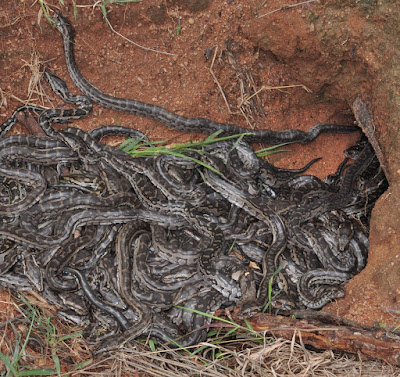 |
Tubuca alcocki
Shih, Chan & Ng, 2018
|
Abstract
A new pseudocryptic species of fiddler crab, Tubuca alcocki sp. n., is described from the northern Indian Ocean. The new species was previously identified with T. urvillei (H. Milne Edwards, 1852), but can be distinguished by the structures of the anterolateral angle of the carapace and male first gonopod. The molecular data of the mitochondrial cytochrome oxidase subunit I gene shows that both are sister taxa and the divergence time is estimated at 2.2 million years ago, around the beginning of the Pleistocene. While the new species is widely distributed in the northern part of Indian Ocean, occurring from the Red Sea to India and the Andaman Sea; T. urvillei sensu stricto has a more restricted range, and is known only from southeastern Africa.
Keywords: mitochondrial cytochrome oxidase subunit I, molecular clock, morphology, new species, Tubuca alcocki, Tubuca urvillei
Systematic account
Family Ocypodidae Rafinesque, 1815
Subfamily Gelasiminae Miers, 1886 (sensu Shih et al. 2016)
Genus Tubuca Bott, 1973
Tubuca urvillei (H. Milne Edwards, 1852)
 |
Figure 6. Tubuca alcocki sp. n.
A–G variation of the live colouration. A, B holotype (CW 30.1 mm, ZRC 2017.1278; Thailand) C adult male (not collected; Phuket, Thailand) D young male (CW 13.0 mm, NCHUZOOL 14897; Thailand). |
 |
Figure 6. Tubuca alcocki sp. n.
E–G variation of the live colouration. E ovigerous female (CW 19.8 mm, NCHUZOOL 14897, Thailand) F, G females in the field (not captured; Phuket, Thailand)
H habitat in Ranong, Thailand. |
Tubuca alcocki sp. n.
Gelasimus Dussumieri H. Milne Edwards, 1852: 148, pl. 4(12) [part; Malabar, India]; Kingsley 1880: 145 [part; list]; Chandy 1973: 402 [Gulf of Kutch, W India] (not Gelasimus dussumieri H. Milne Edwards, 1852 sensu stricto).
Gelasimus acutus – Alcock 1900: 360–361 [Sunderbunds, Mergui; Andamans; Karachi] (not Gelasimus acutus Stimpson, 1858).
Gelasimus Urvillei – Alcock 1900: 362–363 [Nicobars; Madras; Karachi] (not Gelasimus urvillei H. Milne Edwards, 1852).
Uca angustifrons – Lundoer 1974: 8 [Phuket, SW Thailand]; Ng and Davie 2002: 378 [list; Phuket, SW Thailand] (not Gelasimus signatus var. angustifrons De Man, 1892 = Tubuca bellator (White, 1847)).
Uca (Deltuca) [coarctata] urvillei – Crane 1975: 35, 58–61, figs 8B, 9E, pl. 9C, D [part, Pakistan to southern India]; Frith and Frith 1977a: 100–101 [Phuket, SW Thailand] (not Gelasimus urvillei H. Milne Edwards, 1852).
Uca urvillei – Frith et al. 1976: 14, 19, 23–24, 28 [Phuket, SW Thailand]; Tirmizi and Ghani 1996: 103–105, fig. 39 [Pakistan]; Jaroensutasinee et al. 2003: 1–3 [W Thailand]; Jaroensutasinee and Jaroensutasinee 2004: 534, 538, 540–548 [W Thailand]; Naiyanetr 2007: 133 [list; Thailand]; Saher 2008: 21–22, fig. 2.2, pl. 2.1 [Pakistan]; Dev Roy and Nandi 2012: 218 [Nicobar, India]; Hossain 2015: 203, 1 unnumbered fig. [Bangladesh]; Odhano et al. 2015: 170–171, figs 1–2 [Pakistan] (not Gelasimus urvillei H. Milne Edwards, 1852).
Uca (Deltuca) urvillei – Hogarth 1986: 222–223 [Red Sea]; Price et al. 1987: 456, 464 [Red Sea]; Krishnan 1992: 471–472 [Bombay, India] (not Gelasimus urvillei H. Milne Edwards, 1852).
Uca (Deltuca) dussumieri – Krishnan 1992: 471–472 [Bombay, India] (not Gelasimus dussumieri H. Milne Edwards, 1852)
Uca (Tubuca) urvillei – Beinlich and von Hagen 2006: 10, 14, 25, fig. 7f, k [Thailand; India] (not Gelasimus urvillei H. Milne Edwards, 1852).
Uca (Tubuca) acuta – Trivedi et al. 2015: 27 [Gujarat, India] (not Gelasimus acutus Stimpson, 1858).
Tubuca urvillei – Shih et al. 2016: 159, 174 [part], fig. 12A.
Colouration in life: Adults with carapace and legs brown or dark brown, posterior part gray, especially in females (Fig. 6A, C, E). Some females with anterolateral angles orange (Fig. 6E, F) or with dark blotches on blue carapace (Fig. 6G). Major cheliped with fingers white; lower palm deep yellow in large individuals, orange in young individuals; upper palm brown (Fig. 6B–D). Females sometimes with minor chelipeds orange, sometimes with tint of blue (Figs 3F, 6F, G).
Ecological notes: In western Thailand, this species inhabits muddy banks of mangroves (Fig. 6H) and is sympatric with several species of fiddler crabs, including Austruca annulipes (H. Milne Edwards, 1837), A. bengali, Tubuca forcipata (Adams & White, 1849) and T. paradussumieri (cf. Frith and Frith 1977a, 1978; this study). In Pakistan, this species is sympatric with Austruca iranica (cf. Saher et al. 2014).
Etymology: This species is named after Alfred William Alcock, who first recorded this species from India and Pakistan as “Uca urvillei” (cf. Alcock 1900).
Distribution: Western Thailand, India, Pakistan, and the Red Sea (see Remarks).
 |
Figure 6. Tubuca alcocki sp. n.
A–G variation of the live colouration. A, B holotype (CW 30.1 mm, ZRC 2017.1278; Thailand) C adult male (not collected; Phuket, Thailand) D young male (CW 13.0 mm, NCHUZOOL 14897; Thailand) E ovigerous female (CW 19.8 mm, NCHUZOOL 14897, Thailand) F, G females in the field (not captured; Phuket, Thailand)
H habitat in Ranong, Thailand. |
Hsi-Te Shih, Benny K.K. Chan and Peter K.L. Ng. 2018.
Tubuca alcocki, A New Pseudocryptic Species of Fiddler Crab from the Indian Ocean, sister to the southeastern African
T. urvillei (H. Milne Edwards, 1852) (Crustacea, Decapoda, Brachyura, Ocypodidae).
ZooKeys. 747: 41-62. DOI:
10.3897/zookeys.747.23468








































